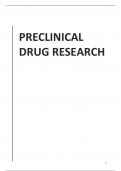PRECLINICAL
DRUG RESEARCH
1
,Overview Module 2
o Chapter 1: Introduction
o Chapter 2: Drug Discovery Process part I
o Chapter 3: Drug Discovery Process part II
o Chapter 4: Pharmacokinetics in Drug Discovery
o Chapter 5: Pharmacology it’s role in drug discovery
o Intermezzo: Drug Development
o Chapter 6: Assessing Drug Safety
o Chapter 7: Genotoxicity
o Chapter 8: Reproduction Toxicity
o Chapter 9: Paediatric Drug Development
o Chapter 10: Pharmaceutical Development
o Chapter 11: Partim Biologicals
2
, Preclinical Drug Research: Clinical Scientific Research
Chapter 1: Introduction
1 Introduction
Phases in drug discovery and development
Drug discovery and development will be done in phases because sponsors won’t lose their money all at
once and thereby not everything is investigated in one time.
Phase 1: Phase where you will expose human volunteers (mostly men) to the new drug.
Aim: To investigate more the PK in a small group (how the drug is absorbed, distributes, and eliminated +
see what the exposure level is).
Phase 2: Small number of patients (have the disease) and a placebo group → You want to know if the drug
has any therapeutic benefits and if there are any adverse effects associated with the drug.
Phase 3: Large group of patients (depending on the disease) in different trial centers .
Molecule -------------------------------------------------------------------------------------> Drug
Chemicals = Small molecules (most used), e.g.: aspirin, fluoxetine, omeprazole.
Natural products = Complex molecules, e.g.: artemether, vinblastine, paclitaxel.
Biologicals = Large (complex) molecules, e.g.: insulin, interferon, EPO (very interesting, but expensive).
2 Drug research and discovery – Pharmaceutical industry
Some facts and figures
Fig 1: R&D spending in different industry sectors
You see that the R&D expenditures per employee to proceed a drug, by manufacturing sub-sector and
industry, is the highest for biopharmaceuticals (105000$) think about gene therapy (also cost much).
Fig 2-4: R&D spending of international pharmaceutical companies and therapeutic areas.
Conclusion: Increased R&D expenditure (spend more for R&D) but less FDA approvals (less new drugs
come to the market due to the fewer FDA approvals! That’s why companies invest in biopharmaceuticals
(e.g. small molecule drugs) because that will gain money. Regions change.
Fig 5: Major disease areas – causes of death by major disease areas in Europe
Top 5 (they cover 85% of the major disease areas linked to death):
1. Diseases of the circulatory system
2. Neoplasms (oncology)
3. Diseases of the respiratory system e.g. asthma, COPD (!)
4. Diseases of the digestive system e.g. Crohn disease
5. Diseases of the nervous system and the sense organs e.g. Alzheimer (very difficult to target a
specific cell population + side effects on other organ systems)
Fig 6: R&D spending
R&D expenditure is the highest for:
• Alzheimer, schizophrenia, depression, epilepsy, Parkinson
• Cancer, osteoporosis, diabetes, obesity
• Atherosclerosis, coronary disease, heart failure
• Infections: viral, bacterial, fungal, parasitic.
Of the total expenditure, 20% will go to the preclinical phase. The clinical
trials are the most expensive ones for a company. Many drugs fail before
coming to the market. You want it to fail as early as possible.
See phases from above.
3




